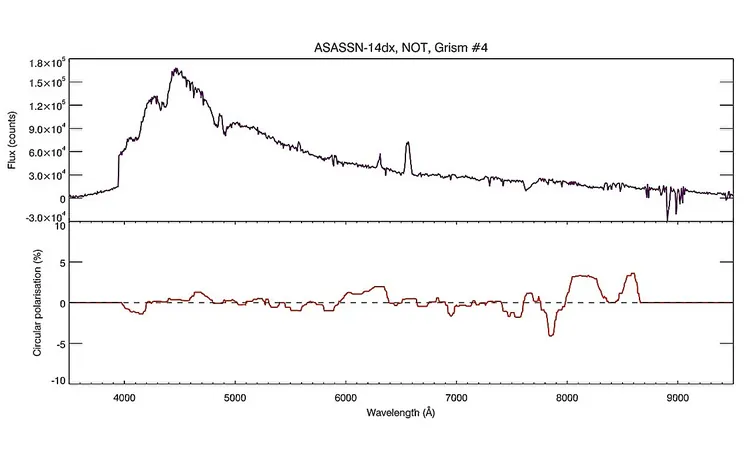
Astronomers Uncover Secrets of a Massive Pulsating White Dwarf in ASASSN-14dx
2025-04-15
Author: Wei Ling
A Dazzling Discovery in the Heart of Space!
An international coalition of astronomers has made groundbreaking observations of the cataclysmic variable star system known as ASASSN-14dx, revealing the presence of a massive pulsating white dwarf. The findings, recently shared on the arXiv preprint server, are set to reshape our understanding of these fascinating celestial phenomena.
What Exactly Are Cataclysmic Variables?
Cataclysmic variables (CVs) are intriguing binary star systems where a white dwarf draws in matter from a companion star, resulting in dramatic fluctuations in brightness. These systems can experience immense outbursts, followed by periods of relative calm.
Meet ASASSN-14dx: A Cosmic Neighbor!
Initially identified in 2014, ASASSN-14dx is not just another distant star; it sits a mere 265 light years away, making it one of the closest CVs to Earth. Observations have determined its orbital period to be about 82.8 minutes, yet much remains mysterious about this stellar pair.
A Closer Look Reveals More!
To unravel the mysteries of ASASSN-14dx, a research team led by Pasi Hakala from the University of Turku utilized various advanced ground-based observatories, including the Nordic Optical Telescope. They employed time-series photometry, circular polarimetry, and optical spectroscopy to uncover the hidden aspects of this captivating system.
Unveiling the Pulsations!
The intense observations unveiled that ASASSN-14dx is not only marked by its orbital period but also features unique pulsation periods—two prominent ones around 4 and 14 minutes. These pulsations add to the complex optical variability observed, hinting at the presence of a massive white dwarf exhibiting non-radial pulsations.
Incredible Mass and Temperature!
The research suggests that the white dwarf within ASASSN-14dx boasts a staggering mass of 1.1 solar masses, coupled with an effective temperature of approximately 16,140 K—higher than any known accreting white dwarf pulsator. This opens up new questions about its formation; the white dwarf may have either been born with a significant mass or accrued more mass than its counterparts throughout its life.
What Lies Ahead?
Interestingly, the researchers highlight that the secondary star lacks sufficient mass to push the white dwarf past the Chandrasekhar limit, the threshold at which a white dwarf can no longer support itself against gravitational collapse. To fully grasp the enigmatic nature of this system, further near-infrared circular polarimetric observations are essential to investigate the magnetic properties of the white dwarf.
A New Chapter in Stellar Research!
As scientists continue to probe the intricacies of cataclysmic variables like ASASSN-14dx, each discovery adds a valuable piece to the puzzle of stellar evolution and the fates of binary systems. Keep your eyes on the skies—the cosmos holds many more secrets!



 Brasil (PT)
Brasil (PT)
 Canada (EN)
Canada (EN)
 Chile (ES)
Chile (ES)
 Česko (CS)
Česko (CS)
 대한민국 (KO)
대한민국 (KO)
 España (ES)
España (ES)
 France (FR)
France (FR)
 Hong Kong (EN)
Hong Kong (EN)
 Italia (IT)
Italia (IT)
 日本 (JA)
日本 (JA)
 Magyarország (HU)
Magyarország (HU)
 Norge (NO)
Norge (NO)
 Polska (PL)
Polska (PL)
 Schweiz (DE)
Schweiz (DE)
 Singapore (EN)
Singapore (EN)
 Sverige (SV)
Sverige (SV)
 Suomi (FI)
Suomi (FI)
 Türkiye (TR)
Türkiye (TR)
 الإمارات العربية المتحدة (AR)
الإمارات العربية المتحدة (AR)